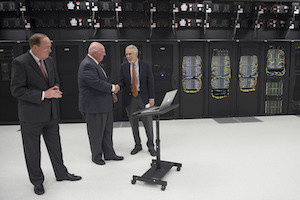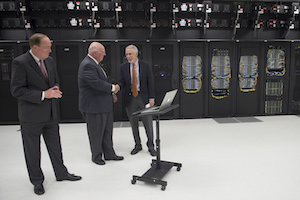 Today Auburn University unveiled its new $1 million supercomputer that will enhance research across campus, from microscopic gene sequencing to huge engineering tasks. The university is also initiating a plan to purchase a new one every few years as research needs evolve and expand.
Today Auburn University unveiled its new $1 million supercomputer that will enhance research across campus, from microscopic gene sequencing to huge engineering tasks. The university is also initiating a plan to purchase a new one every few years as research needs evolve and expand.
Many of our research projects require terabytes of data,” said John Liu, Auburn University associate provost and associate vice president for research. “This supercomputer offers Auburn researchers unprecedented computer power. The higher level of capability and capacity allows us to be very competitive in the era of Big Data as we analyze large amounts of information.”
The Lenovo supercomputer is actually a collection of 120 computers called “nodes” tied together into a coherent system controlled by a “head node,” with its speed ranking in the top 1 percent in the world in terms of access to the large pool of shared storage. Each node has 20 cores that process information, which means 2,400 cores are available for the computational needs of researchers.
The system has more than 16 terabytes of memory and 1.4 petabytes of disk space. One terabyte equals one million megabytes, while one petabyte is 1,000 terabytes. A typical personal computer has 8 megabytes of memory and 500 megabytes of disk space.
Auburn has named its new supercomputer the “Hopper” in honor of the late Rear Admiral Grace Hopper, an extraordinary woman whose work laid the foundation for much of today’s computing work.
Computer technology plays such an important role in all research today,” said Nicholas Giordano, dean of the College of Sciences and Mathematics. “Many Auburn faculty and students will benefit from it, and it will help Auburn recruit new faculty, who can hit the ground running.”
Each researcher can have his or her own resources on the machine, which is housed in the Office of Information Technology building.
“We designed our building to accommodate this type of setup when we built it four years ago,” said Bliss Bailey, chief information officer in the Office of Information Technology. “Researchers will still use their desktop computers to access our ‘Hopper’ supercomputer.”
The university will be able to better utilize research funding because researchers will not have to buy individual hardware and software for individual projects and because colleges will not have to build space with advanced electrical and cooling systems. Researchers also will not have to rent computer space and time on supercomputers with outside agencies or companies.
“The new supercomputer will allow our researchers to do all of their work here, and to spend more of their funding on the actual research,” Liu said. “The machine will provide more opportunities for graduate and undergraduate students as well. Our students need to be trained with state-of-the-art infrastructure.”
The university installed a supercomputer in its Hubbard Center for Advanced Science, Innovation and Commerce, or CASIC, building three years ago. Computer technology is estimated to become obsolete every six years, so Auburn plans to replace one of its supercomputers every few years.
“The new supercomputer is four times faster,” Bailey said. “We want to have multiple machines available for researchers, with incorporating the latest technology.”
Source: Auburn University
Sign up for our insideHPC Newsletter




